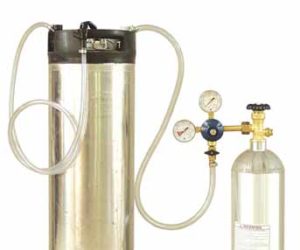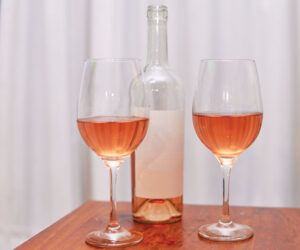
Q
How many pounds of grapes will make five gallons (19 L) of wine? Are there guidelines for reds and whites and varieties within each of those groups? How much does vintage affect the amount required?
James Freidan
Akron, Ohio
A
You’ll need about 85 to 90 pounds (39 to 41 kg) of fresh grapes (still on their stems) to make five gallons of wine. It will start off at about 2.5 lug boxes of grapes and will end up as about 25 bottles, or two cases, of wine. The final volume of wine you get depends entirely upon how much juice you squeeze out of the grapes, whether you press before fermentation as in a white wine or press after fermentation as in a red wine. The final volume, therefore, will be affected by all things that affect the quantity of juice recovered from those lug boxes. For example if there are many tiny berries per grape cluster, you can assume that there will be a higher percentage of solids/liquid, both in the form of skins and seeds and in the grape stems that house each of those tiny berries. In large, loose clusters where the stem/berry ratio is less and the skin/juice ratio is less, pound for pound you will recover more liquid from those grapes.
We could be splitting hairs, here, however. Even though there are varietal to varietal variations on berry size, stem weight, and other factors, it’s almost impossible to accurately gauge how much juice will come from a certain lot of grapes unless you have years of experience working with grapes and know what volumes they have yielded in the past.
Another monkey wrench to throw in is the year-to-year variation in processing parameters as well as the winemaker-to-winemaker differences inherent in the winemaking process. Your friend down the road may take 100 pounds of grapes and press the heck out of them to yield seven gallons of wine, whereas your winemaking regime, with its gentler pressing, may yield only five gallons.
Unfortunately there is no easy answer to your question. We are at the whim of Mother Nature, who one year may make your Cabernet vineyard full of fine, heavy clusters when one year she may make half the berries per cluster too tiny to yield any juice at all. All a winemaker can do is make estimations, gain experience, and go from there.
Q
If bentonite is a clearing agent why do my kit instructions say to add with the yeast? Why not add it after?
Anne Jacobs
Chicago, Illinois
A
It actually can be harmful to add bentonite to the juice or must along with the yeast. Bentonite is added as a fining agent to remove proteinaceous materials from wine that can cause ugly hazes and other instabilities. If added at the beginning of the fermentation, the bentonite can make unavailable beneficial amino acids and other proteins that are essential for a healthy fermentation. Since yeast are made up largely of proteins and need protein in the wine to survive and conduct a fermentation rapidly and to completion, it’s recommended to proceed with a bentonite fining once the fermentation is finished.
Q
My partners and I, for the first time, bought Merlot grapes last year. We followed our normal procedure, which we have been using for the past five years for the red grapes we used, including Zinfandel, Barbara and Carignan. We plucked about 75 percent of the grapes off the stems prior to crushing. We used pasteur Champagne yeast and the grapes were in the primary fermentation container for five days. We now have the wine in carboys. It has cleared up in good shape but there is a yellow ring around the top of the wine. The wine tastes good and has a good aroma, but what’s with the yellow ring?
Dan Bowers
Kenosha, Wisconsin
A
Sounds like ring around the bathtub to me! Or maybe we should call it ring around the fermenter! Going on the information you’ve given me and if my wino intuitions are correct, your “yellow ring” is probably a deposit of post-fermentation residue, especially if you put the five-day fermented wine into the carboy before the wine had finished fermenting to dryness.
As I’m sure you’re well aware, winemaking is not a sterile process, and well, wine tends to leave goop, glop, and globs of gook wherever it goes throughout the entire production process. I’ve seen my share of thick layers of lees, skins, and other winemaking detritus in fermenters, barrels, and bottles as well as on the periphery of carboys or stainless steel tanks. In your particular situation, what seems to have happened is that your yeast wasn’t quite done with its job yet when you put it into your carboys. As the yeast cells sputtered through their last degrees or two Brix, they decided to, in cohorts with evolving carbon dioxide, minute particles of suspended pigments (that aren’t always necessarily red), and stirred-up yeast lees, effect a deposit of post-fermentation gook up the sides of their container. Add more time (the time it might take for newly fermented wine to clear up) and the small amount of evaporation that can occur in a carboy with a fermentation lock on it, and the wine level will sink ever so slightly, revealing the debris as a ring-around-the-carboy that even though it looks ugly, is entirely harmless.
As a more microbiologically involved answer along the same lines, it’s possible that along with your Pasteur yeast you somehow got some surface-dwelling microaerophillic organisms (there are a few bacteria and yeast species that come to mind). These guys can live in wine and especially like to hang out in that just-right zone between the non-oxygenated wine in the carboy and the barely-oxygenated layer of mixed carbon dioxide gas and air that exists in the headspace of a post-fermentation carboy. These organisms that have paid you a visit, thankfully, do not seem to have spoiled your wine.
If what you’ve described in your question seems to be at the wine-carboy interface and can be categorized into the general “wine crud” category, do not despair. I’d just rack when you’re ready into a clean container and continue to enjoy your wine. If not, try to examine every step of your procedure and find out what it was you did differently this year. Ring around the carboy is common; rings of vibrant yellow slime are not.
Q
I’ve heard homemade wines go bad after two years. What causes that and how can I prevent it?
Tom Alton
Grand Island, Neb.
A
As Miss Manners would say, “Do not despair, gentle reader.” It is absolutely a falsehood t hat homemade wine “goes bad” after two years. It has just as much potential for staying power as the greatest grand crus in the world. It is simply that we humble home winemakers usually don’t have access to the raw materials that many commercial wineries do. Excellent grapes can make excellent wines, and the sad truth of the matter is that many home winemakers start out with mediocre or poor-quality materials, either in the form of unripe orchard fruits or kits that are flavorless, unbalanced, or way past their sell-by date. Check your home winemaking retailer for recommendations on kits.
However depressing of a situation that might seem, home winemakers the world over are still able to make some extremely age-worthy wines that will still be worth drinking in 10 years. It’s just a question of building quality and stability into every stage of production that the wine goes through. Though that may sound like a huge generalization that is very hard to put one’s finger on, some winemakers have found a “recipe” for success that works for them. Even though there’s no magic bullet that works wonders across all wines, many winemakers find that the key to longevity is a balance between adequate acidity (some like pHs of 3.3 to 3.6), high enough alcohol content (12 percent and above), microbiological stability, and proper storage. Heat, light, oxygen, and microbes are some of wine’s worst enemies while aging. All care should be taken to store wine bottles on their sides in a cool, dark, and relatively humid environment. Being a conscientious winemaker who pays attention to all of the above factors and isn’t afraid of putting in some long hours is the first step on the road to making great wines.







